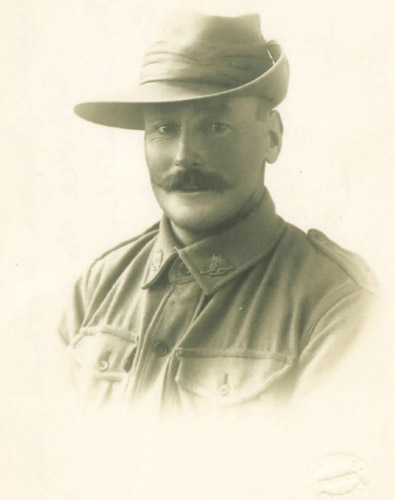Additions will be checked before being published on the website and where possible will be forwarded to the person who submitted the original entries. Your contact details will not be forwarded, but they can send a reply via this messaging system.
please scroll down to send a message
Pte. Alan James Mather
Australian Imperial Force. 33rd Btn.
from:Inverell, NSW
(d.8th Jun 1917)
In August 2008, archaeologists from the group No Man's Land - The European Group for Great War Archaeology, recovered the body of an unknown Australian soldier missing since the Battle of Messines in 1917. Extensive detective work and close cooperation between the Group, professional partners and the Australian Army over the past 20 months has now revealed the soldier's identity as 1983 Private Alan James Mather.
The Australian soldier's remains were discovered during work on The Plugstreet Project, an archaeological investigation of part of the Belgian battlefields of the First World War. Archaeological excavation was able to recover the skeleton, as well as associated objects, including rifle, ammunition, Corps badges and the contents of his pockets and haversack. Although a corroded identification disc was also recovered, forensic investigation failed to provide identification details.
Project co-Director Martin Brown said:
"Using archaeological techniques to lift and study the remains we were able to build up quite a picture of the man, and this led us a long way to his identity. The badges gave us his nationality. His location in the field gave us his unit, 33rd Battalion, and that tells us when he was killed because they didn't spend long there. The fact he was wearing all his ammunition and grenades showed that he was in the main attacking force and gave us his Company.
Excavation was only the first part of the story. Experts from Bradford University cleaned and conserved the objects which helped us to tell something about the soldier himself. He wasn't wearing his helmet when he died, probably preferring his Australian Slouch Hat as a symbol of unit identity. Equally intriguing were the remains of a German Pickelhaube (spiked helmet) in his knapsack. This appears to have been a trophy of war captured on a trench raid. He should have left it with his heavy kit in the rear but preferred to carry it into action: he probably didn't trust some of his "mates" in the rear echelon! If he'd survived the war it might now be a treasured family heirloom."
Project co-Director Richard Osgood said:
"The scientific input from our academic and scientific partners was astounding. Work by Universities of Leuven, Cranfield and Oxford studying the chemical composition of his bones enabled us to narrow down the place of birth of the skeleton to a few locations in New South Wales. Comparing that data to the casualty lists further reduced the number of possible identities for this man to five possibles.
Forensic analysis of the bones had given us height, age and likely body type from muscle attachments. Even before we knew it was Mather we knew he had lived a fairly physical life, developing heavy muscle attachments on his bones and showing wear on his spine.
With such a low number of candidates the Australian Army commissioned DNA testing of the surviving relatives of all the casualties fitting the profile, which resulted in a positive match with one of the Next of Kin donors. This match provided the final proof in identifying Private Mather.
This result shows how integration of the fieldwork, use of historical documents and cutting edge science can produce very satisfying outcomes."
1983 Private Alan James Mather joined the Army in 1916. He was a grazier from Inverell in New South Wales, where his father had been mayor. He was survived by his parents, older twin sisters, Flora and Marion, a younger sister, Elsie, a half brother Doug and a half sister, Jessie. Following his death his Company Commander wrote that "he was one of my best and most trusted men". He was 37 years old at the time of his death, which was caused by shell-fire on the 8th June 1917 at St Yvon, Belgium.
He had no known place of burial and so was commemorated on the Menin Gate in Ypres, where the names of missing are listed.
Thanks to archaeology and science Private Mather will now be formally buried by the Australian Army on July 22nd at Prowse Point Commonwealth War Graves Cemetery. His name will be removed from the panel at the Menin Gate in due course."
Australian Minister for Veterans Affairs, Alan Griffin said:
"I am extremely pleased that we have been able to restore the identity of this Australian soldier who was missing for almost a century."
Please visit www.plugstreet-archaeology.com for further information.
ABC Radio interviews with Pte Mather's family
